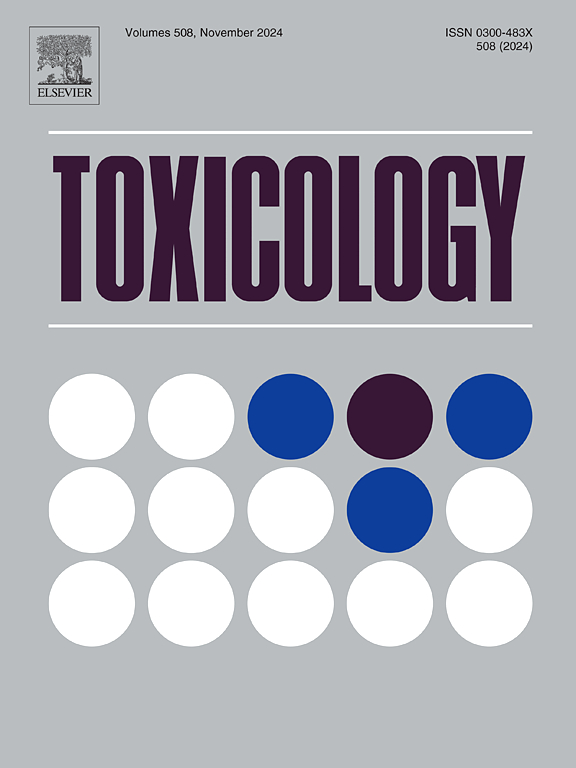甲状腺相关生物活性数据与体内暴露比较的解释:体外脱碘酶活性推定化学抑制剂的优先方法
IF 4.8
3区 医学
Q1 PHARMACOLOGY & PHARMACY
引用次数: 0
摘要
许多ToxCast检测终点可以映射到甲状腺不良结果通路(AOP)网络中的分子起始事件(MIEs)。在此,我们提供了一个解释甲状腺相关生物活性数据的框架。为了验证这一概念,我们利用ToxCast数据研究了去碘酶(DIO)的抑制作用,并确定了最有可能抑制DIO酶的物质。去碘酶能将甲状腺激素转化为活性和非活性形式。4个相关的无细胞体外测定的数据可用于>; 2000种化学物质的单浓度筛选和327种化学物质的多浓度筛选。我们通过过滤来确定对每种DIO酶表现出抑制作用的化学物质,这些化学物质不太可能被分析干扰所混淆,从而将推定的活性化学物质列表从523个细化到135个。然后利用体外生物活性数据,利用一种新的高通量毒物动力学(HTTK)模型估算给药等效剂量(aed),用于体外到体内外推(IVIVE)剂量。为了考虑在适当的生命阶段和剂量背景下潜在的甲状腺干扰活动,我们扩展了现有的人类母胎HTTK模型,以允许涉及妊娠前三个月的模拟。对于许多化学物质,使用模拟的胎儿组织浓度比单独使用模拟的母体血浆浓度产生更低的AED估计,至少部分原因是我们的全妊娠HTTK模型的保守假设。这种可扩展的方法可用于MIE组的ToxCast甲状腺相关生物活性数据,可为妊娠和发育期间潜在不良后果的进一步筛查或分析提供信息。本文章由计算机程序翻译,如有差异,请以英文原文为准。
Interpretation of thyroid-relevant bioactivity data for comparison to in vivo exposures: A prioritization approach for putative chemical inhibitors of in vitro deiodinase activity
Many ToxCast assay endpoints can be mapped to molecular initiating events (MIEs) within the thyroid adverse outcome pathway (AOP) network. Herein, we provide a framework for interpretation of thyroid-relevant bioactivity data across MIEs. As a proof-of-concept, we used ToxCast data on the inhibition of deiodinase (DIO) enzymes, which convert thyroid hormones between active and inactive forms, and identified substances most likely to inhibit DIO enzymes. Data from 4 relevant cell-free in vitro assays are available for > 2000 chemicals in single concentration screening and 327 chemicals in multi-concentration screening. We filtered to identify chemicals that demonstrated inhibition for each DIO enzyme less likely to be confounded by assay interference, refining the list of putatively active chemicals from 523 to 135. In vitro bioactivity data were then used to estimate administered equivalent doses (AEDs) using a novel high-throughput toxicokinetic (HTTK) model for in vitro to in vivo extrapolation (IVIVE) of dose. To consider potential thyroid-disrupting activity in an appropriate life-stage and dose context, we extended an existing human maternal-fetal HTTK model to allow for simulations involving the first trimester of pregnancy. For many chemicals, using modeled fetal tissue concentrations produced lower AED estimates than using modeled maternal plasma concentrations alone, at least partially due to conservative assumptions in our HTTK model of complete gestation. This extensible approach for MIE groups of thyroid-related bioactivity data from ToxCast may inform further screening or analyses for potential adverse outcomes during pregnancy and development.
求助全文
通过发布文献求助,成功后即可免费获取论文全文。
去求助
来源期刊

Toxicology
医学-毒理学
CiteScore
7.80
自引率
4.40%
发文量
222
审稿时长
23 days
期刊介绍:
Toxicology is an international, peer-reviewed journal that publishes only the highest quality original scientific research and critical reviews describing hypothesis-based investigations into mechanisms of toxicity associated with exposures to xenobiotic chemicals, particularly as it relates to human health. In this respect "mechanisms" is defined on both the macro (e.g. physiological, biological, kinetic, species, sex, etc.) and molecular (genomic, transcriptomic, metabolic, etc.) scale. Emphasis is placed on findings that identify novel hazards and that can be extrapolated to exposures and mechanisms that are relevant to estimating human risk. Toxicology also publishes brief communications, personal commentaries and opinion articles, as well as concise expert reviews on contemporary topics. All research and review articles published in Toxicology are subject to rigorous peer review. Authors are asked to contact the Editor-in-Chief prior to submitting review articles or commentaries for consideration for publication in Toxicology.
 求助内容:
求助内容: 应助结果提醒方式:
应助结果提醒方式:


